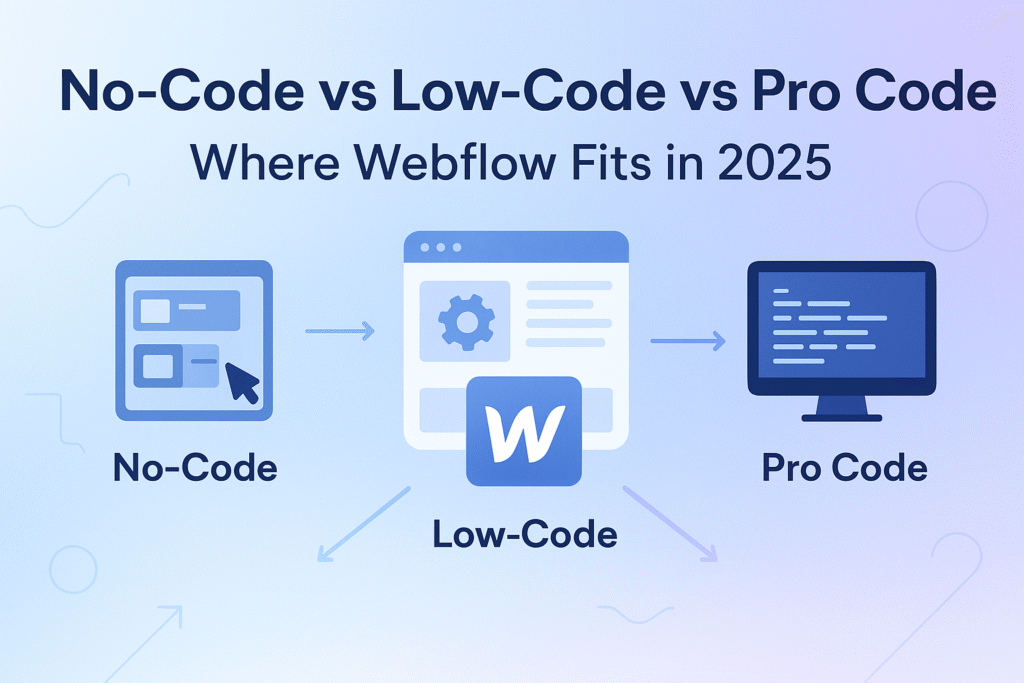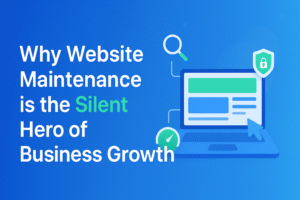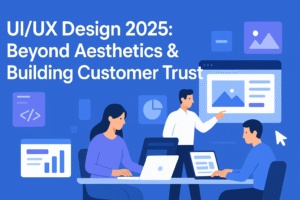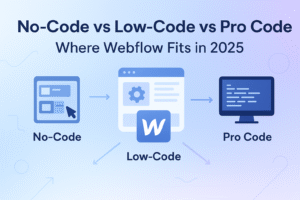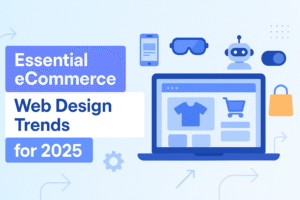Introduction
The web development landscape is shifting rapidly in 2025. What once required teams of developers and months of coding can now be achieved in weeks—or even days—thanks to no-code and low-code platforms. Startups, agencies, and even enterprises are rethinking how they approach digital products.
One platform that consistently makes headlines is Webflow. Initially seen as a simple no-code design tool, Webflow has matured into a serious player in both the no-code and low-code markets. This has sparked a new conversation: Is Webflow still a no-code tool, or is it bridging the gap between no-code and pro code?
To answer this, let’s take a closer look at the three main approaches to building digital products—No-Code, Low-Code, and Pro Code—and explore how no code Webflow fits into web development trends 2025.
Understanding the Three Approaches
1. No-Code Development
No-code platforms are designed for non-developers. They allow anyone with an idea to create a website, app, or workflow without touching a single line of code. Using drag-and-drop interfaces, pre-built components, and visual editors, no-code tools have empowered millions of entrepreneurs, designers, and small businesses to bring their ideas to life.
Some of the most popular no-code platforms in 2025 include Webflow, Wix Studio, Bubble, and Softr. Among these, the Webflow no-code platform stands out because it combines professional-level design flexibility with ease of use. Unlike template-heavy builders, Webflow allows creators to customize everything while keeping development visual and intuitive.
Pros of No-Code:
- Extremely fast development cycle.
- Low cost compared to hiring developers.
- Empowers non-technical users to launch projects independently.
Cons of No-Code:
- Limited for complex backend systems.
- Scaling large enterprise applications can be challenging.
- Relies heavily on the platform’s built-in features.
✅ Best for: Entrepreneurs, agencies, freelancers, and small businesses that need polished websites quickly without relying on developers.
2. Low-Code Development
Low-code platforms strike a balance between visual development and custom coding. While much of the app or website can be built using a drag-and-drop interface, developers can extend functionality by writing small amounts of custom code.
This makes low-code particularly attractive to enterprises that want both speed and scalability. Tools like OutSystems, Mendix, and FlutterFlow are leaders in this space. In many cases, low-code platforms are used to accelerate development while still allowing IT teams to integrate APIs, databases, and automation.
In 2025, the rise of low-code is reshaping corporate digital transformation. Instead of spending months coding enterprise apps, companies can now deliver internal tools, dashboards, and customer apps in weeks.
Pros of Low-Code:
- Faster development than traditional coding.
- Flexibility to add custom logic.
- Suitable for complex workflows and integrations.
Cons of Low-Code:
- Requires some technical knowledge.
- Licensing and subscription costs are often higher.
- Can become restrictive for very large, complex systems.
✅ Best for: Mid-to-large businesses, enterprise apps, and projects that need speed but also customization.
3. Pro Code Development
Pro code represents the traditional way of building applications—from scratch, using frameworks, libraries, and full programming languages. Developers have unlimited control over how applications are built, integrated, and scaled.
Popular frameworks and languages in 2025 include React, Next.js, Angular, Vue.js, Django, and Laravel. With pro code, the only limitation is your team’s expertise and resources.
While pro code offers complete freedom, it also comes with challenges. Building complex systems from scratch requires significant investment in time, money, and skilled developers. Maintenance is ongoing, and deployment cycles can take months rather than weeks.
Pros of Pro Code:
- Total flexibility and customization.
- No platform limitations.
- Best for long-term scalability and complex products.
Cons of Pro Code:
- Time-consuming and costly.
- Requires a skilled development team.
- Slower speed-to-market compared to no-code or low-code.
✅ Best for: Enterprise-grade software, SaaS platforms, and highly technical projects that require complete control.
Low-Code vs Pro Code 2025: The Debate
One of the hottest topics in the tech industry is the debate around Low-Code vs Pro Code 2025. The choice often comes down to business priorities:
- Speed-to-Market vs Flexibility: Low-code allows companies to ship products faster, but pro code gives ultimate flexibility.
- Short-Term Costs vs Long-Term Investment: Low-code tools often lower upfront costs but may introduce limitations later, whereas pro code requires high investment but ensures long-term freedom.
- Scalability vs Accessibility: Pro code scales better, but low-code makes development more accessible to teams with fewer technical resources.
In 2025, many companies are adopting hybrid models—using Webflow or other no-code tools for customer-facing websites while building backends and critical apps with pro code frameworks. This hybrid approach balances agility with control.
Where Does Webflow Fit in 2025?
When Webflow launched, it was seen as a no-code website builder primarily for designers and freelancers. But in 2025, its identity has evolved. Webflow is now positioned between no-code and low-code.
Here’s why:
- The Webflow no-code platform empowers non-technical users to create visually stunning websites.
- Developers can extend Webflow with custom code embeds, API integrations, and Webflow Logic, making it function more like a low-code tool.
- Enterprises are adopting Webflow because of its CMS, ecommerce features, hosting performance, and security compliance.
This means no code Webflow is no longer just for personal projects or agencies. It’s now competing with low-code platforms, making it a key part of digital transformation strategies in 2025.
Web Development Trends 2025
The rise of platforms like Webflow also ties directly into broader web development trends 2025:
- AI-Powered Development
- AI is being integrated into no-code and low-code platforms, helping users auto-generate layouts, content, and SEO strategies.
- Webflow has started to include AI-driven design suggestions, reducing manual work for creators.
- Hybrid Development Models
- Companies increasingly use Webflow for frontend while integrating pro code backends for scalability.
- This approach allows for rapid prototyping while maintaining long-term flexibility.
- Enterprise Adoption of No-Code
- In 2025, more large corporations are adopting no-code Webflow solutions for marketing, microsites, and ecommerce.
- The stigma around “no-code is only for small projects” is fading fast.
- Focus on Speed + Scalability
- Businesses want both quick deployment and room to grow. Webflow’s hybrid capabilities make it a strong choice in this space.
These trends suggest that the future of development is not about choosing between no-code, low-code, or pro code—it’s about using each where it makes the most sense.
Conclusion
In 2025, the boundaries between no-code, low-code, and pro code are no longer clear-cut. Businesses have more options than ever to build the digital experiences they need.
- Use no code Webflow if you need a visually stunning, fast-to-market website.
- Use low-code platforms when you require moderate customization and integrations.
- Use pro code frameworks for large-scale, enterprise applications that demand total flexibility.
The rise of Webflow has redefined what it means to be a no-code platform. With enterprise adoption, AI features, and custom code options, Webflow sits at the intersection of no-code and low-code—making it one of the most versatile tools in the modern developer’s toolkit.
Looking ahead, the future of web development will be shaped not by one approach, but by a blend of no-code, low-code, and pro code. And in that blended future, Webflow has firmly secured its place as a leader in the web development trends 2025.




